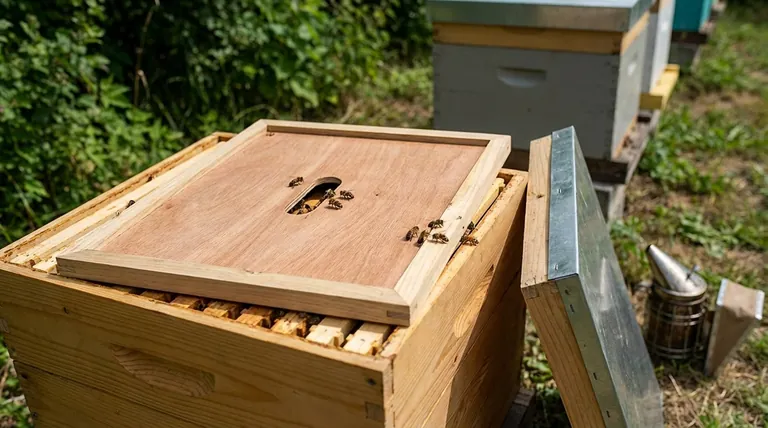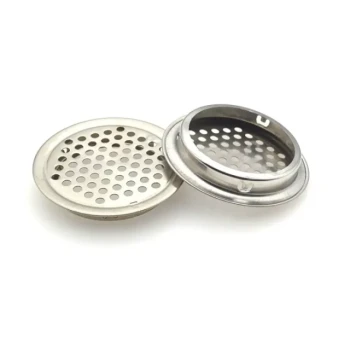Primarily, beekeepers use an inner cover to create a manageable barrier between the colony and the main outer lid. Bees instinctively seal any gaps in their hive with a sticky resin called propolis, which can effectively glue the heavy outer cover directly to the hive body, making it incredibly difficult to remove without jarring the entire colony.
The inner cover is not just a secondary lid; it is a multi-function tool that simplifies hive inspections, helps regulate the hive's internal environment, and prevents the colony from permanently sealing the hive shut.

The Core Problem: Propolis and Bee Space
The primary driver for the inner cover's existence is a combination of bee behavior and the physical design of the hive. It directly addresses the problem of propolis.
What is Propolis?
Bees create propolis, often called "bee glue," from plant resins. They use this incredibly sticky, antimicrobial substance to seal cracks, reinforce the comb, and defend the hive against intruders.
The "Glued Shut" Dilemma
When only a large, telescoping outer cover is used, bees will deposit propolis in the gap between the cover and the top hive box. In hot weather, this propolis becomes extremely sticky and strong, effectively cementing the lid in place.
Trying to pry off a glued-down outer cover requires significant force. This action sends loud noises and vibrations through the hive, alarming the colony and making a peaceful inspection nearly impossible.
How the Inner Cover Solves This
The inner cover creates a dead air space and a much smaller, more predictable surface for the bees to seal. Breaking the propolis seal on a lightweight inner cover is a simple, quiet task for the beekeeper, causing minimal disturbance to the colony below.
Beyond Propolis: The Inner Cover's Other Critical Roles
While managing propolis is its primary job, the inner cover serves several other essential functions for hive health and management.
Regulating Ventilation and Moisture
Most inner covers feature a small notch on one edge or a hole in the center. This opening is critical for providing an upper entrance and, more importantly, ventilation. It allows excess moisture from the bees' respiration to escape, preventing condensation from dripping down on the cluster, which can be fatal during winter.
Creating a Calmer Inspection Experience
The inner cover allows for a two-stage opening process. A beekeeper can first remove the outer cover, then puff a small amount of smoke through the inner cover's hole. This gives the smoke time to pacify the guard bees before the hive is fully exposed, leading to a much calmer and safer inspection.
Providing a Platform for Feeding
The central hole is perfectly designed for feeding. A beekeeper can place a jar of syrup upside down over the hole, allowing the bees to feed with minimal exposure to the outside elements and without the beekeeper having to fully open the hive.
Understanding the System's Design
The inner and outer covers work together as a system, each with a distinct purpose. Ignoring the inner cover fundamentally misunderstands this system.
Inner Cover vs. Outer Cover
The inner cover is for the beekeeper's interface and internal hive climate control. It manages bee access, simplifies inspections, and handles ventilation.
The telescoping outer cover is for external environmental protection. Its job is to shield the entire hive from rain, snow, and sun, protecting the wooden components from the weather. Its metal top ensures durability and prevents leaks.
Why Not Just Use an Outer Cover?
Relying solely on an outer cover sacrifices control. It forces the beekeeper into disruptive inspections, eliminates options for top ventilation, and makes feeding more cumbersome and stressful for the colony. The small cost and effort of using an inner cover pay significant dividends in hive health and ease of management.
Using the Inner Cover Effectively
Applying this knowledge allows a beekeeper to manage their colony more strategically throughout the year.
- If your primary focus is routine inspections: Use the inner cover's central hole to apply smoke before removal, ensuring a calmer colony.
- If your primary focus is winter survival: Position the inner cover to use its notch for essential upper ventilation, preventing deadly moisture buildup.
- If your primary focus is feeding your colony: Place a feeder over the inner cover's hole to provide nutrition with minimal disturbance to the hive.
Ultimately, the inner cover transforms the top of the hive from a simple lid into a strategic interface for effective hive management.
Summary Table:
| Key Function | Benefit for the Beekeeper |
|---|---|
| Prevents Propolis Sealing | Easy, non-disruptive hive openings without jarring the colony. |
| Regulates Ventilation | Manages moisture to prevent deadly condensation, especially in winter. |
| Facilitates Calm Inspections | Allows for pre-inspection smoking through the center hole. |
| Provides Feeding Platform | Enables easy top-feeding with minimal disturbance to the bees. |
Ready to upgrade your hive management? HONESTBEE supplies commercial apiaries and beekeeping equipment distributors with the durable, precision-crafted inner covers and other essential supplies needed for healthy, productive colonies. Contact our wholesale experts today to discuss your needs and streamline your beekeeping operations.
Visual Guide

Related Products
- Inner Beehive Cover for Beekeeping Bee Hive Inner Cover
- Stainless Steel Round Beehive Air Vents for Ventilation
- Professional Insulated Winter Hive Wrap for Beekeeping
- Professional Drop-Style Hive Handles for Beekeeping
- HONESTBEE Advanced Ergonomic Stainless Steel Hive Tool for Beekeeping
People Also Ask
- What is the function of an inner cover in a beehive? Essential for Hive Health & Management
- How is the inner cover used to promote ventilation? Master Hive Climate Control for Healthy Bees
- What is the role of inner covers in insulated beehives? Master Moisture Control for a Healthy Colony
- What is the role of the inner cover in a beehive? Essential Climate Control for Hive Health
- What is the purpose of the inner cover in a beehive? A Key to Hive Health & Easy Management



















